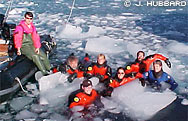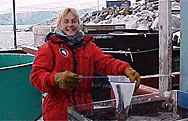|
 |
 |
February 2, 2004, a team of seven scientists will embark on an adventure of discovery to the coldest place on Earth, the frozen continent of Antarctica. The team – lead by University of Alabama at Birmingham (UAB) biologists Charles Amsler, Ph.D., and James McClintock, Ph.D., and by chemist Bill Baker, Ph.D., from the University of South Florida – will spend three months diving below the ice off Palmer Station, investigating the survival secrets of a kaleidoscopic array of marine life. The team also will study the health of the brown macroalgae – seaweeds – an important link in the Antarctic food chain.
“We are looking at the chemical defenses of marine plants and animals and endeavoring to understand exactly how they use these chemicals to defend themselves – how they wage chemical warfare, you could say,” McClintock, who holds the UAB Chair of Polar and Marine Biology, said. “This will allow scientists to understand the ecological structure of Antarctic marine life.”
“The work,” Amsler adds, “will be important not only to understanding marine life in Antarctica but, more significantly, to marine and terrestrial organisms all over the world."
While the project’s aim is to understand how these organisms function in the environments, the toxic defense compounds of the invertebrates could one day play a role in the prevention of diseases like heart disease, cystic fibrosis, cancer, and AIDS.
“This is the only place on earth where some of the organisms studied can be found,” McClintock said.
The mission, funded by the Office of Polar Programs at the National Science Foundation, continues research pursued by Amsler, McClintock, and Baker. This is their fourth trip in five years to the harsh, snowy realm of Palmer Station, Antarctica. The scientific world, as well as the public, followed their journeys and discoveries via the WOW.UAB.EDU Web site and through articles in American Scientist, Nature, and The Wall Street Journal.
|
 |
 |
In addition to studying predator defenses in a variety of marine macroalgae, sponges, echinoderms and nudibranchs, they also will study the health of the brown macroalgae, the dominant organisms in shallow water marine communities along the Antarctic Peninsula. Brown algae provide food and shelter for a wide variety of marine animals. The team will study how ultraviolet radiation effects the production of chemical defenses by the seaweeds. Some animals are more sensitive to the defenses than others, and the chemicals must break down before the seaweed can be eaten. If UV radiation increases the levels of these defensive chemicals this can affect how quickly the seaweed can be turned into food, thus affecting the entire Antarctic food chain.
Palmer Station
Palmer Station sits on a protected harbor on the southwestern coast of Anvers Island off the Antarctica Peninsula. Palmer is the only U.S. Antarctic station north of the Antarctic Circle. The temperature is mild, with monthly averages ranging from minus 10 degrees Celsius (14 degrees Fahrenheit) in July and August to 2 degrees Celsius (36 degrees Fahrenheit) in January and February.
The station, built on solid rock, consists of two major buildings and three small ones, plus two large fuel tanks, a helicopter pad, and a dock. Construction was completed in 1968, replacing a prefabricated wood structure ("Old Palmer,'' established in 1965) two kilometers away across Arthur Harbor.
About 40 people can occupy Palmer. The winter population can drop to as low as 10, although Palmer does not have a long period of winter isolation as does McMurdo Station, the other research site often used by the team. McMurdo, about 1,000 kilometers due south, is the largest research station in Antarctic, providing facilities for as many as 1,000 people.
McClintock said at Palmer Station macroalgae and invertebrate larvae are much more abundant than at McMurdo Sound, but as they search for these organisms they will have to be vigilant in spotting and keeping away from dangerous leopard seals, which are common in these waters.
|
 |
 |
“The waters off Palmer Station are an excellent area to work, in terms of marine life diversity,” McClintock said. “We do have to be careful diving because of leopard seals but there are more than 120 species of marine plants, as well as numerous sponges and soft corals to study. Part of what makes Palmer Station a good place to dive is the islands off shore. The waters we will work in range from 30- to 130-feet deep.”
“The peninsula supports luxuriant undersea forests of macroalgae [seaweed],” Amsler added. “And they literally are forests, with biomass levels comparable to the giant kelp forests you can see off the west coast of the United States and elsewhere. Coupled with the unique oceanography of the region, this makes the Peninsula an ideal place to pose the scientific questions we are working on in this project.”
Joining Amsler, McClintock, and Baker on the expedition are UAB graduate student Kevin Peters, B.S, M.S.; UAB post-doctoral student Anne Fairhead, Ph.D.; UAB researcher Maggie Amsler, M.S.; Jim Garey, Ph.D., USF biology professor, and Hla Win, a USF graduate student.